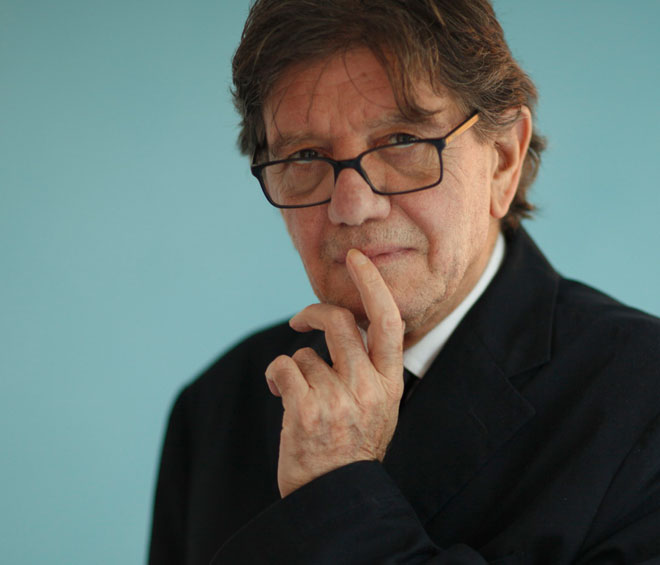
by ANGERIA RIGAMONTI di CUTÒ
Ettore Spalletti’s (b1940, Cappelle sul Tavo) second exhibition with Marian Goodman brings together examples of his enduring Paesaggio quasi-monochromes – suggestions of the fugitive space between sea, mountain and sky – cubic sculptures, and new paintings in his characteristic azure, their pulverised surfaces now punctuated with deleted corners, discreet reminders of the canvas’s three dimensions. Pencil and pastel works on paper, preludes to the Paesaggio series, are also on display in the Librairie Marian Goodman.
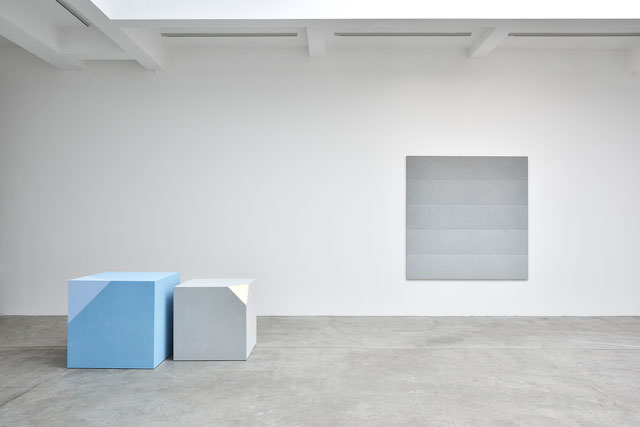
Installation view, Ettore Spalletti, Ce qu’il y a de plus profond dans l’homme c’est la peau, Galerie Marian Goodman Paris, 2018. Photograph: Rebecca Fanuele. Courtesy of the artist and Galerie Marian Goodman Paris.
A solitary artist who favours the tautly controlled environment of his studio in central Italy’s Abruzzo region, Spalletti relates his enthralment with light, uncertainty as to whether he is an abstract or figurative painter, and the search for a meditative sphere within a painting.
Angeria Rigamonti di Cutò: You have often described the process by which you craft your finely finished works: laying down colour 10 to 15 times over as many days, closely controlling drying times, abrading the surface and, finally, waiting for the pigment to break through and settle into the final colour. This seems like a mysterious, almost alchemical process where you can’t know exactly what will emerge. Since you’ve used the same process for so long, are you now less surprised by the results?
Ettore Spalletti: I prepare an impasto of oils diluted with pigments and gesso. I then apply a thin layer of colour, every day, at the same time, for 15 or 20 days until I obtain the thickness I want to achieve. You can’t see the final colour during this process. Only at the end, when the pigments diffuse over the surface through sanding, does the colour appear.
When I initially developed this technique I often didn’t obtain the colour I had in mind, so I would start all over again. In my earlier pictures, there are layers of stratified colour, but now I’ve become more expert.
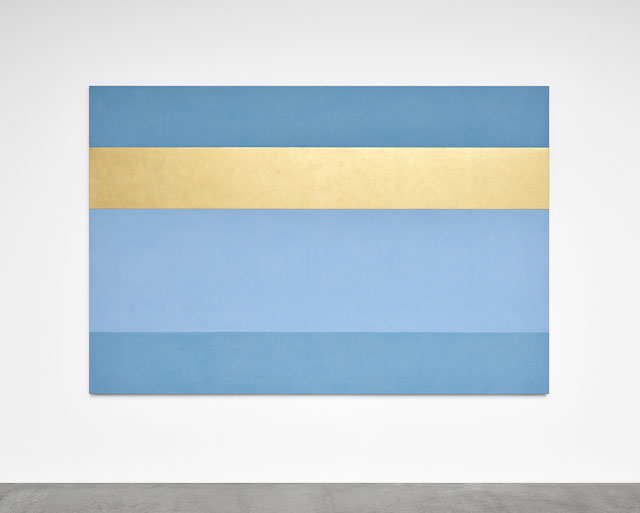
Ettore Spalletti. Azzurro e oro, paesaggio, 2018. Colour impasto and gold leaf on board, 78 3/4 x 118 1/8 x 1 5/8 in (200 x 300 x 4 cm). Photograph: Rebecca Fanuele. Courtesy of the artist and Galerie Marian Goodman Paris.
ARC: Your core colours are blue, pink and grey, shades you associate respectively with the atmosphere, human skin and the reception of other colours. You have described an early chromatic source as the Coppa Acerbo car race with the strong colour blocks it displayed in your childhood surroundings. Are colour, form and light virtually inseparable for you?
ES: Light is very important in my work, both in the way the paintings cast light on the viewer and the space they inhabit. My colours are absorbent. If you look at one of my works, you can’t tell whether the colour of the surface is moving inwards, or if it’s emanating from inside and appears on the surface.
Every day when I go to my studio I look for a light or shadow in the atmosphere that might point me towards a new colour. The colour then suggests a form. The colours that most characterise my works are blue and pink. Blue is the colour of the atmosphere in which we’re always immersed; it’s the colour of the sky. Our feet step on the green of lawns or the brown of earth, but our bodies are enveloped in blue. I use pink as the colour of skin, which is never stable but shifts along with our moods. For me, grey is welcoming and works well with all other colours.
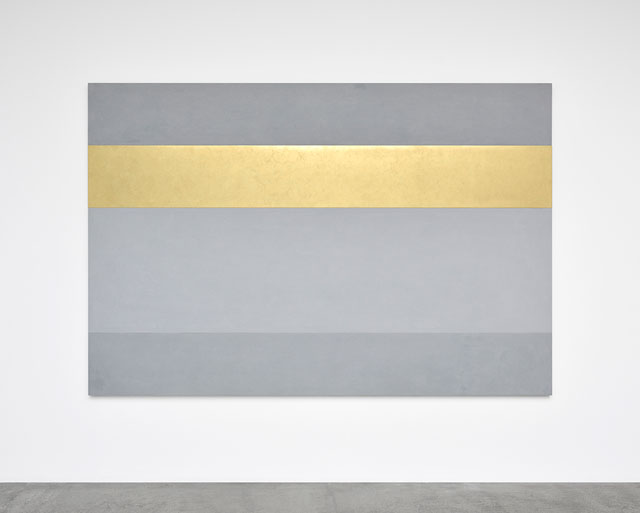
Ettore Spalletti. Grigio e oro, paesaggio, 2018. Colour impasto and gold leaf on board, 78 3/4 x 118 1/8 x 1 5/8 in (200 x 300 x 4 cm). Photograph: Rebecca Fanuele. Courtesy of the artist and Galerie Marian Goodman Paris.
ARC: You are often described as a painter of monochromes – although strictly speaking that isn’t true since your surfaces are chromatically so transformative – but you have defined yourself as a figurative painter. How so?
ES: Where can the imagination of a colour take you? At times, a yellow can lead me so far away into the light that I don’t even know whether I’m an abstract or figurative painter. I sometimes like to describe myself as a figurative painter because colour can always take me to a different place, but it’s always a place inside me, with its own rules and reasons. I often give my works figurative names.
ARC: Your work has travelled a lot – you’ve participated twice in Documenta and several times at the Venice Biennale. But you mostly stay in the studio in a relatively remote area in Abruzzo, away from what are considered art centres. Were you never tempted by the idea of an extended leave from the protected space of your studio?
ES: I have travelled a lot; when I was younger I was away for lengthy periods at times. I liked, and still like, returning home.
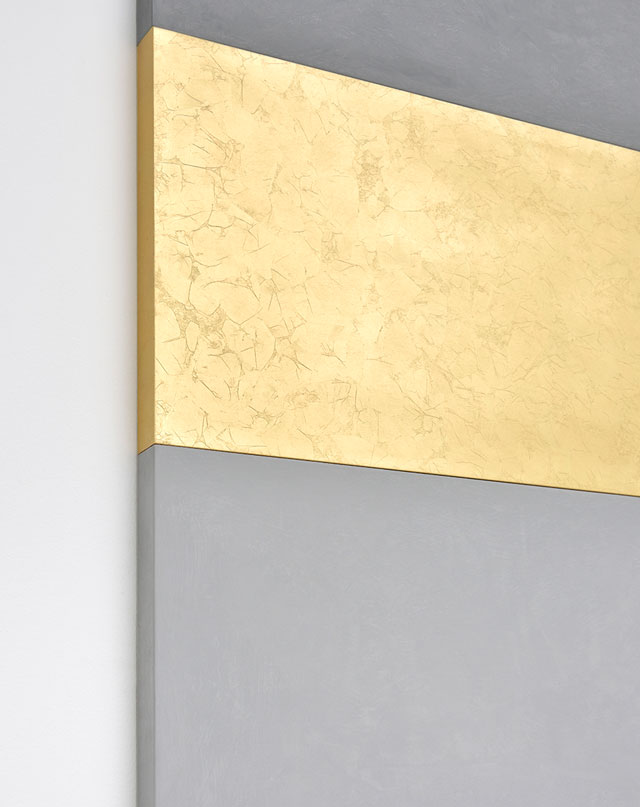
Ettore Spalletti. Grigio e oro, paesaggio, 2018 (detail). Photograph: Rebecca Fanuele. Courtesy of the artist and Galerie Marian Goodman Paris.
ARC: At the same time, thanks to the presence of Mario Pieroni’s influential gallery in nearby Pescara, various artists visited, particularly ones associated with arte povera and conceptualism, among others Joseph Beuys, Jannis Kounellis and Gino De Dominicis. How did the presence of these visitors affect your work, if at all?
ES: Mario Pieroni was, and still is, a dear friend. He lived nearby in Pescara where he opened his first gallery. I followed his work with great interest and often had dinner with the artists he exhibited. I should also mention Lucrezia De Domizio’s gallery, which was on the same street.
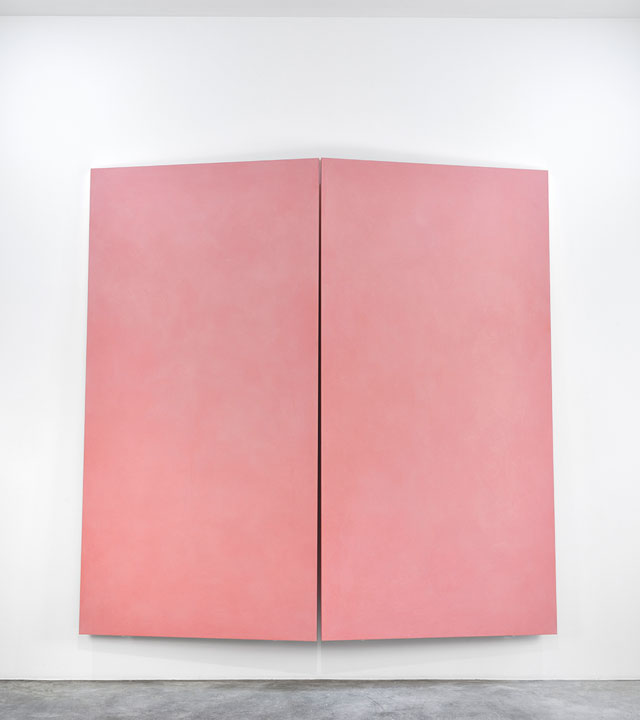
Ettore Spalletti. Porpora, 2016. Colour impasto on board, gold leaf, two elements: 110 1/4 x 55 1/8 x 1 5/8 in (280 x 140 x 4 cm) each. Photograph: Rebecca Fanuele. Courtesy of the artist and Galerie Marian Goodman Paris.
ARC: Your studio has been filmed various times, including in the documentary by the Neapolitan director Pappi Corsicato, who has created many cinematic portraits of major artists. Given the apparent inseparability between your studio, work and life, is it important to film the space to appreciate the entirety of your art?
ES: The still camera and film camera convey something different. The studio, over time, becomes more and more my home, my garden, my sky. And I like to see it clear, clean, cloudless.
ARC: You’ve made collaborative works, at times with conspicuously different artists, for example Haim Steinbach at the Guggenheim, Maurizio Cattelan and Enzo Cucchi at the 1997 Venice Biennale. In one of his curated installations Joseph Kosuth placed your work in dialogue with his own texts and a Giorgio Morandi painting – the latter a more obvious pairing. Since your work seems self-contained, albeit porous, what was your experience of collaborative work?
ES: One evening at dinner, Joseph Kosuth and I were talking about Giorgio Morandi. Our mutual interest in his work prompted us to come up with the idea for an exhibition called Three Separate Moments in One Contemplation. I worked on a fountain with Franz West. I also remember meeting Lothar Baumgarten at Documenta in Kassel. I maintained close friendships with all of them.
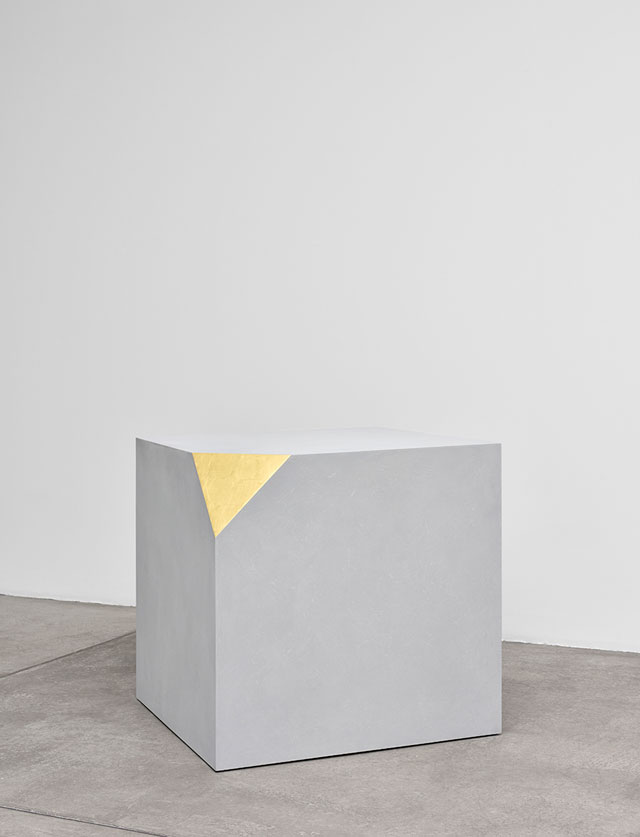
Ettore Spalletti. Così com'è, grigio, 2006. Colour impasto on wood, gold leaf, 31 1/2 x 31 1/2 x 31 1/2 in (80 x 80 x 80 cm). Photograph: Rebecca Fanuele. Courtesy of the artist and Galerie Marian Goodman Paris.
ARC: You and your wife designed a chapel and wake room in Abruzzo and you previously designed a Salle des départs for a Paris hospital. How does the very particular concept of death inform these works?
ES: The Salle des Départs was the first time I created a work for a hospital. I was young and very shy. Both Dr François Paraireand Professor Michel Durigou were very supportive. Thanks to them I was able to cope with an environment I wasn’t used to. A new and interesting aspect of that experience was the fact that I came to know in detail the place that would house and conserve my work, something that doesn’t usually happen. I had always thought about, and wanted, to see my works in a specific context that one could “touch” and imagine in every detail, from floor to ceiling.
In my work there’s always the desire to create a space where you feel good, enveloped and somehow protected. What I value most is giving, finding within oneself something to offer.
At Villa Serena, in Città Sant’Angelo near Pescara, my wife, Patrizia Leonelli, designed a chapel and an adjacent wake room. When I was asked to add something to the chapel, I felt I was being offered a space dedicated to everyone because spiritualty is a universal value. I wasn’t interested in an iconographic narrative – I thought of the church as a contemplative space, a place where you can pray or simply sit in silence. For me, this is exactly what one seeks in a picture.
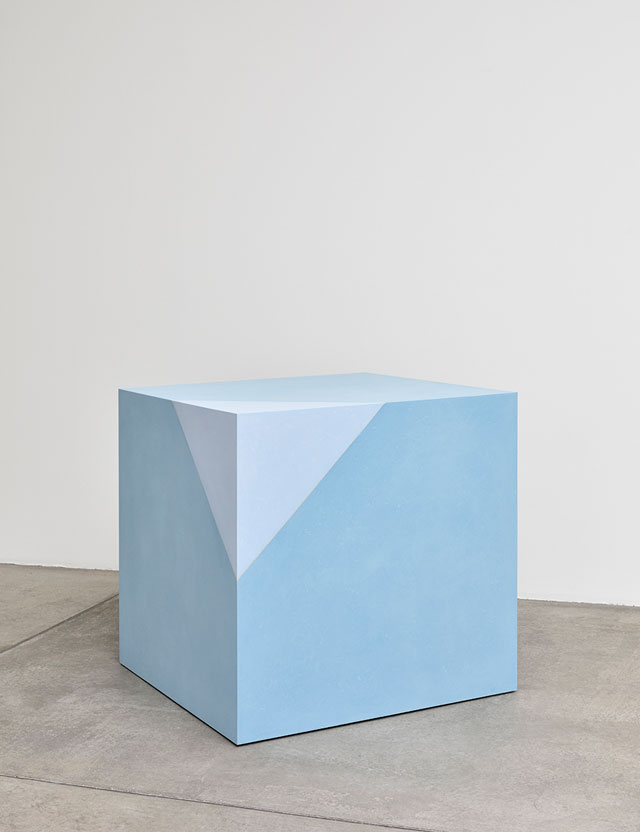
Ettore Spalletti. Senza parole, 2018. Colour impasto on wood, gold leaf, 35 3/8 x 35 3/8 x 35 3/8 in (90 x 90 x 90 cm). Photograph: Rebecca Fanuele. Courtesy of the artist and Galerie Marian Goodman Paris.
ARC: Your current exhibition at Marian Goodman takes the line of a Paul Valéry imaginary philosophical dialogue as its title, one that refers to an important feature of your work: skin, something that both protects and exposes. It’s not the first time you’ve cited poets in your titles but you’ve also transcribed poems on to the back of some of your paintings, creating a kind of parallel, shadow series. Why do you do this?
ES: I love reading poetry and often transcribe verses on the back of my paintings. It’s an encounter. As is the exhibition at the Marion Goodman gallery, first in London, then in Paris. The title of the London show was taken from a poem by Emily Dickinson. Now I’m back at home, in my studio, full of the welcome and serenity I found in Paris and the gallery.
• Ettore Spalletti: Ce qu’il y a de plus profond dans l’homme, c’est la peau is at Galerie Marian Goodman, Paris, until 26 May 2018.